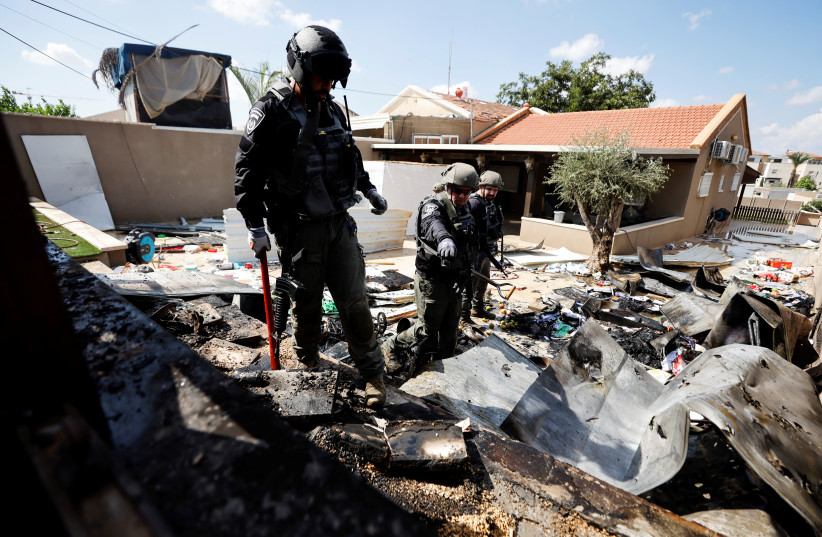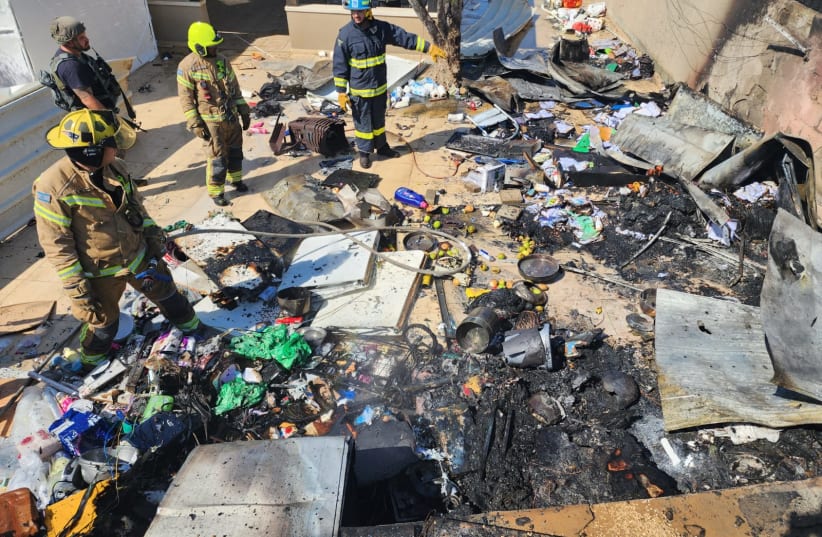Sderot is the largest of the cities that Israel evacuated in the wake of the Hamas attack on October 7. For two decades, the city was a symbol of Israel’s steadfastness and resilience in the face of terrorism. However, after October 7, there is a lot of uncertainty about what comes next.
Nevertheless, residents are returning. Noam Ivri Adanani is one of those residents. Along with his wife and her family, he left Sderot for hotels at the Dead Sea, where Israel evacuated people from Sderot on the fifth day of the war.
“Now there is a stronger sense of security, and the rocket fire has radically decreased. Northern Gaza has been taken over by the IDF. Hamas and the other terrorist groups have been degraded there,” Ivri Adanani says. It has been a difficult experience. During the first days of the war in Sderot, the residents stayed indoors because of the terrorist threat.
They emerged after three days and then found themselves being evacuated. Dozens of Hamas terrorists attacked Sderot and killed numerous people in the city. The terrorists also attacked the Sderot police station, killing police and leading to an all-night battle. Eventually, the police station was destroyed to defeat the terrorists. Sixty-one Israeli police died fighting the wave of Hamas terror on October 7, some of them in Sderot.
A sense of losing the war among residents in Sderot
Before the war, Sderot had weathered previous rounds of fighting. The Chabad house in the city even has a Menorah made from pieces of rockets that fell on the city. Armored shelters are everywhere. It’s a city that knew how to live with rocket fire, but Hamas infiltrating the city and a war stretching into its fifth month was not something the city had calculated.


“There was a sense in the community of Sderot evacuees that Israel had lost to Hamas, at least temporarily. In previous conflicts, we had a few days of a mostly air-based war and rockets fired at Israel, and authorities might evacuate a few elderly, or give a stipend to some people whose businesses or livelihoods were affected by the war; but people leaving their homes for an indefinite period – months or a maybe even a year – that was frustrating and rejecting,” Ivri Adanani says.
When the people of Sderot were evacuated, they joined 100 other communities around the border of Gaza and in northern Israel. The evacuations are a new policy for Israel, essentially admitting that communities on the borders cannot be defended against the kind of genocidal attack Hamas carried out and which Hezbollah might attempt.
The Ministry of Defense discussed its project, Northern Horizon, on February 1. “Currently, the directorate has identified 427 damaged houses, including 80 directly affected,” in the north. The damage in the south is much more significant. In Sderot, though, the issue is not damage but returning a city to its normal, thriving life.
Ivri Adanani recalls leaving Sderot in October and passing the farm of former Prime Minister Ariel Sharon. It brought up memories of Disengagement from Gaza. “There was a sentiment about this, even before Oct. 7, that Disengagement was a mistake, and Sderot bore the brunt of it, and other Gaza border communities,” he says.
Ivri Adanani evacuated with his wife and members of her family. He brought only a small amount of stuff with him. One thing he brought was his army gear, and within days, he was called to reserve duty and packing to go to Hebron, where he served.
Israel’s policy during the war has been to house the evacuees at hotels. For small communities that often have only a few hundred residents, the government tried to house them in the same hotel. For Sderot, a city of 30,000, this required numerous hotels. It was chaotic. The Ivri Adananis went to one hotel and then another.
They ended up at the Herber Samuel Milos. “It was me, my wife, mother-in-law, and wife’s sister, and several aunts and uncles and their kids – all in all, we were about fifteen. About half of them would later leave the Dead Sea, going to Eilat or Jerusalem to rent an apartment and live more organically in a functioning city rather than a hotel resort area not intended for long-term stays as refugees in their own country,” he recalls.
At the hotel, the people ate in shifts because there were so many. Eventually, some community services were provided, such as medical needs or meetings with therapists. There was some positives to the hotels, the trauma of becoming a refugee in one’s own country could be temporarily addressed by some hotel benefits, such as the pool or spa. “I wasn’t in the mood for any fun or leisure activities, and preferred to watch the news and spot any traces of hope that the government would pursue the necessary mission to destroy Hamas,” says Ivri Adanani.
The Dead Sea was safe from attack, more than Eilat, where some evacuees had to experience sirens due to the Houthi threat. However, there were apprehensions about attacks from other fronts and the fact Israel was entering a long war. There also wasn’t much to do at the Dead Sea. Ein Bokek doesn’t have a lot of restaurants or places to go, unlike Eilat. Children had to attend school remotely.
“The hotels, to their credit, did set up a lot of activities for kids, such as daycares. But I think a lot of kids got anxious. They built a makeshift playground for the kids near the hotel. Then Bnai Akiva and other youth groups began reconstituting their activities for displaced kids.
So there was a little bit of trying to make it seem like a more organic community,” Ivri Adanani says. Meanwhile he got to play an important role in reserve duty in the West Bank. “Summarizing reserve duty, I felt a point of pride representing my people in these times of darkness and using Arabic and English to the best that I could to make Israel safer.
It was a multifaceted ordeal, trying to help the West Bank Palestinians who are not pro-terrorism and want to go on with their lives without incidents, and trying to lower the tensions,” he recalls.
After more than a month in the Dead Sea, his family did get to briefly return to Sderot during the pause in fighting in late November. “We saw that our home, thankfully, was undamaged by rockets, and there were no leaks or power outages. We had our first Shabbat there in late December, a family get together with a lot of relatives returning to their homes in Sderot,” he says.
Now they are back in the city. However, he estimates only thirty to forty percent of residents have returned. Many who have children have not. In addition, many businesses are still not open. There is a sense of security but there is much more to do. He estimates only half the synagogues, for instance, have a minyan, or the traditional ten men needed to conduct Jewish communal prayer.
The city feels more secure, and there are soldiers at the entrances to Sderot. “This will make people feel more comfortable even years into the future when, God-willing, there is no more Hamas in Gaza,” he says. Government subsidies remain for some, but they are dismally small.
Some of the people may not return to their communities in the future. However, many people in Sderot are resolute, Ivri Adanani says. “And you will have new families from central Israel that might feel a sense of patriotic duty or cheap apartments, people seeking to get out of the crowded Tel Aviv metro area.
There are reservists deployed in Sderot with whom I spoke, who had never been to the city prior to the war, and when they saw the city was intact and had wide boulevards and modern schools, they were impressed with what a great place to live it could be, especially if postwar not next to a hostile terror entity.”
There are also other changes in the city. Whereas Palestinian workers once came to work in these areas, now there are foreign workers, such as Chinese, doing construction. “There are a lot of very dynamic changes already showcasing Sderot’s vitality during the war and hinting at how it could look the day after,’” Ivri Adanani concludes.
